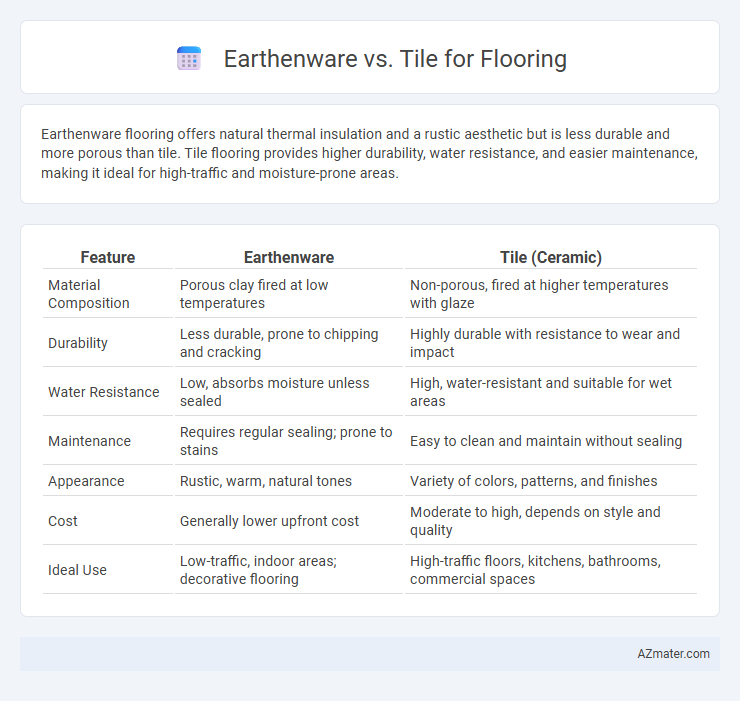Earthenware flooring offers natural thermal insulation and a rustic aesthetic but is less durable and more porous than tile. Tile flooring provides higher durability, water resistance, and easier maintenance, making it ideal for high-traffic and moisture-prone areas.
Table of Comparison
| Feature | Earthenware | Tile (Ceramic) |
|---|---|---|
| Material Composition | Porous clay fired at low temperatures | Non-porous, fired at higher temperatures with glaze |
| Durability | Less durable, prone to chipping and cracking | Highly durable with resistance to wear and impact |
| Water Resistance | Low, absorbs moisture unless sealed | High, water-resistant and suitable for wet areas |
| Maintenance | Requires regular sealing; prone to stains | Easy to clean and maintain without sealing |
| Appearance | Rustic, warm, natural tones | Variety of colors, patterns, and finishes |
| Cost | Generally lower upfront cost | Moderate to high, depends on style and quality |
| Ideal Use | Low-traffic, indoor areas; decorative flooring | High-traffic floors, kitchens, bathrooms, commercial spaces |
Introduction to Earthenware and Tile Flooring
Earthenware flooring consists of natural clay-based tiles fired at relatively low temperatures, offering a rustic, porous surface ideal for dry indoor areas. Tile flooring includes a broader range of materials such as ceramic, porcelain, and stone tiles, known for durability, water resistance, and versatility in design. Understanding the composition and characteristics of earthenware versus tile flooring helps determine the best application for aesthetic preferences and functional requirements.
Material Composition and Manufacturing Process
Earthenware flooring consists primarily of natural clay mixed with water, shaped, and fired at lower temperatures (about 1,000degC), resulting in a porous, softer material prone to chipping. Tiles, often ceramic or porcelain, are made from refined clay combined with minerals like silica and fired at much higher temperatures (1,200degC or above), creating denser, harder surfaces ideal for high-traffic areas. The manufacturing process of tile involves precise molding and glazing techniques, enhancing durability and moisture resistance compared to the more rustic, less sealed earthenware.
Aesthetic Appeal and Design Versatility
Earthenware flooring offers a warm, rustic aesthetic with natural textures and earthy tones that enhance traditional and Mediterranean-style interiors. Tile flooring provides extensive design versatility, available in various materials, patterns, colors, and finishes, making it suitable for both contemporary and classic spaces. The durability and customizable options of tiles allow for intricate designs, while earthenware adds unique character through handcrafted imperfections.
Durability and Longevity Compared
Earthenware flooring is generally less durable and more porous than tile, making it prone to chipping and water damage over time. Porcelain and ceramic tiles offer superior hardness and resistance to wear, providing greater longevity and low maintenance in high-traffic areas. Proper sealing and installation of earthenware can extend its lifespan, but tiles remain the preferred choice for long-term durability in flooring applications.
Water Resistance and Maintenance Needs
Earthenware flooring is porous and requires sealing to enhance water resistance, making it more susceptible to moisture damage if untreated, while tiles, especially ceramic and porcelain, offer superior water resistance with minimal sealing needed. Maintenance for earthenware involves regular resealing and careful cleaning to prevent staining and deterioration, whereas tile flooring demands simpler upkeep, typically involving routine sweeping and mopping without special treatments. Choosing between these materials depends on the environment's moisture exposure and the desired balance between aesthetic appeal and long-term durability.
Cost Differences and Budget Considerations
Earthenware flooring generally offers a lower upfront cost compared to tile, making it a budget-friendly choice for large areas or renovations. Tile flooring, while often more expensive initially, provides greater durability and lower maintenance costs over time, potentially reducing long-term expenses. Budget considerations should balance the initial investment against lifespan and upkeep, with earthenware suited for cost-sensitive projects and tile ideal for higher durability demands.
Installation Methods and Labor Demands
Earthenware flooring requires careful hand-laying and precise alignment due to its porous and fragile nature, demanding skilled labor for proper sealing and grout application. Tile installation, particularly with ceramic or porcelain, often involves standardized processes like thin-set mortar application and spacers that can be executed more quickly by less specialized workers. The labor demands for earthenware are higher because of additional preparation and finishing steps to ensure durability and moisture resistance.
Environmental Impact and Sustainability
Earthenware flooring is made from natural clay baked at lower temperatures, resulting in a smaller carbon footprint compared to the high-energy production process of ceramic or porcelain tiles. The biodegradability of earthenware makes it an eco-friendly option, whereas tile flooring often contains non-renewable materials and compounds that can persist in landfills. Sustainable flooring choices favor earthenware for its reduced environmental impact and use of locally sourced, natural raw materials.
Suitable Applications and Room Recommendations
Earthenware flooring is ideal for low-traffic areas such as living rooms, sunrooms, and covered patios due to its porous nature and rustic aesthetic. Tiles, especially ceramic or porcelain, offer superior durability and moisture resistance, making them suitable for high-traffic spaces like kitchens, bathrooms, and entryways. Choosing between earthenware and tile depends on room function, desired appearance, and maintenance requirements, with tile favored for wet or heavy-use environments.
Conclusion: Choosing the Best Flooring Option
Earthenware offers a rustic, natural aesthetic with good thermal insulation but requires sealing for durability and moisture resistance. Tiles provide a wide variety of styles, higher durability, and easier maintenance, making them suitable for high-traffic areas. Choosing between earthenware and tile depends on factors such as climate, usage, maintenance preferences, and design goals to achieve the best flooring solution.

Infographic: Earthenware vs Tile for Flooring
 azmater.com
azmater.com